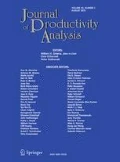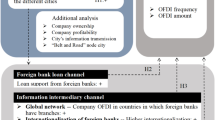Abstract
This paper aims to assess the impact of both geographic and industrial diversification of economic activities on the productivity performance of large European R&D Multinational Enterprises (MNEs). Based on the worldwide subsidiaries of these firms, we measure the performance of the firms according to their level of industrial diversification and globalisation that we proxy with the presence and importance of subsidiaries in the EU, North America and Asia–Pacific regions. The sample consists of large R&D firms that represent about 80 % of total European R&D. In general, the results indicate a positive impact from globalisation on firms’ R&D productivity, especially in the US, while a negative impact for industrial diversification is found.


Similar content being viewed by others
Notes
See Cincera et al. (2010) for a discussion.
This excess value is defined by the authors as the “log of the ratio of the firm’s total market value to the sum of the imputed market values of its segments”. The authors use three measures of industrial diversification: the reporting of more than one business segment, the average number of business segments, and a sales-based Herfindahl index across business segments. Due to limitations in their data, the authors cannot use the number of countries as a measure of global diversification. Instead, they use the fraction of firms that are globally diversified and the fraction of total sales that come from foreign subsidiaries.
Descriptive statistics reported in this study show that the average R&D intensity is higher for multinational firms and lower for industrially diversified firms.
The definition of “R&D” is that used by companies, following accepted international accounting standards (IAS38), in accordance with the definitions used in official statistics (as defined in the OECD’s Frascati Manual). The term “R&D Investment” is used in the Scoreboard.
Amadeus, September 2009 version.
This contact list is confidential and the work on this information was performed by Michele Cincera as a visiting scientist at the DG-JRC Institute for Prospective Technological Studies, European Commission, Seville.
Comparison is made for 2007 as it is the most recent year available in our version of Amadeus. Correlation between employees or sales in both databases is 0.99. The mean sales ratio for scoreboard/sales in Amadeus is 1.04, with a median of 1. The mean employees ratio in scoreboard/employees in Amadeus is 1.05, with a median of 1.
34 of them belong to the financial sector (bank, insurance and other financials) which is not covered in Amadeus.
The indicators to measure the global diversification and industrial diversification used in this paper are based on HHI index. While this index is normally used to measure the level of concentration rather than diversification, use of the HHI index to measure geographic and or business diversification is also well documented in the literature (Comment and Jarrell 1995; Berger and Ofek 1995).
Data on employees are only available for some subsidiaries, while data on sales are only available for other subsidiaries. In total, we do not have information on sales or employees for 48 % of these subsidiaries.
In addition, financial information for these subsidiaries is only available for a given year (over 2005–2007). One limitation of the study is that it was not possible to collect this information over the period investigated, i.e. 2000–2008, since 63 % of these subsidiaries do not have any BvD ID in the Amadeus Database. The reasons explaining why this information is partially available (only for some subsidiaries and only for 1 year) are twofold. First, a large share of these subsidiaries are small companies in terms of size, i.e. in terms of number of employees, total revenues or total assets, and therefore no information on sales and on employees is collected by Amadeus. The second reason rests in the geographic coverage of the Amadeus database which contains information only for companies in both Western and Eastern Europe. Therefore, if a subsidiary is registered in a country outside Europe, it is not included in the database. A further complication rests in the fact that the number of subsidiaries itself is changing over time through the process of merger and divestiture of the multinational companies listed in the R&D scoreboards.
European Union (27 Member States).
American Samoa, Australia, Brunei, People's Republic of China, Fiji, Federated States of Micronesia, Guam, Hong Kong, Indonesia, Japan, Cambodia, Kiribati, North Korea, South Korea, Laos, Marshall Islands, Myanmar, Macau, Northern Mariana Islands, Malaysia, Nauru, New Zealand, Papua New Guinea, Philippines, Palau, Solomon Islands, Singapore, Thailand, Timor-Leste, Tonga, Tuvalu, Taiwan, Vietnam, Vanuatu and Samoa.
See Appendix 1 for more detailed statistics.
A non-logarithmic specification does not affect the significance or signs of the diversification measurements.
When the model in column 1 of Table 10 is estimated with fixed-effects, the elasticities of labour, physical capital and R&D capital are 0.72, 0.15 and 0.12, respectively.
Excluding observations in 2006 yields similar conclusions.
There is a huge literature dealing with these motives. See Cincera et al. (2010) for a recent review and discussion.
A similar equation could also be estimated for the industrial diversification.
References
Asakawa K (2001) Evolving headquarters-subsidiary dynamics in international R&D: the case of Japanese multinationals. R&D Manag 31(1):1–14
Baysinger B, Hoskisson RE (1989) Diversification strategy and R&D intensity in multiproduct firms. Acad Manage J 32(2):310–332
Berger PG, Ofek E (1995) Diversification’s effect on firm value. J Financ Econ 37:39–66
Burgelman RA (1983a) A process model of internal corporate venturing in the diversified major firm. Adm Sci Q 28:223–245
Burgelman RA (1983b) A model of the interaction of strategic behavior, corporate context, and the concept of strategy. Acad Manag Rev 8:61–70
Capron H, Cincera M (1998) Assessing the R&D determinants and productivity of world-wide manufacturing firms. Ann Econ Stat 49(50):565–587
Chandler A (1962) Strategy and structure: chapters in the history of American industrial enterprise. MIT Press, Cambridge
Cincera M, Cozza C, Tübke A (2010) Drivers and policies for increasing and internationalising R&D activities of EU MNEs. IPTS working paper on corporate R&D and innovation, no. 02/2010. Office, Luxembourg
Comment R, Jarrell GA (1995) Corporate focus and stock returns. J Financ Econ 37:67–87
Denis DJ, Denis DK, Yost K (2002) Global diversification, industrial diversification, and firm value. J Financ 57(5):1951–1979
Dundas KNM, Richardson PR (1982) Implementing the unrelated product strategy. Strateg Manag J 3:287–301
Dunning J, Narula R (1995) The R&D activities of foreign firms in the United States. Int Stud Manag Organ 25(1–2):39–73
Griliches Z (1979) Issues in assessing the contribution of research and development to productivity growth. Bell J Econ 10(1):92–116
Hall BH, Mairesse J (1995) Exploring the relationship between R&D and productivity in French manufacturing firms. J Econom 65:263–294
Hayes RH, Abernathy WJ (1980) Managing our way to economic decline. Harv Bus Rev 58(4):67–77
Hill CWL, Hitt MA, Hoskisson RE (1988) Declining U.S. competitiveness: innovation, the M-form structure and the capital markets. Acad Manag Executive 2:51–60
Jensen MC, Murphy KJ (1990) Performance pay and top management incentives. J Polit Econ 98:225–264
Kamien MI, Schwartz NL (1982) Market structure and innovation. Cambridge University Press, Cambridge
Kuemmerle W (1997) Building effective R&D capabilities abroad. Harv Bus Rev 75(2):61–70
Kumar N (2001) Determinants of location of overseas R&D activity of multinational enterprises: the case of US and Japanese corporations. Res Policy 30:159–174
Le Bas C, Sierra C (2002) ‘Location versus home country advantages’ in R&D activities: some further results on multinationals’ locational strategies. Res Policy 31:589–609
Meyer M, Milgrom P, Roberts J (1992) Organizational prospects, influence costs, and ownership changes. J Econ Manag Strategy 1:9–35
Morck R, Yeung B (1998) Why investors sometimes value size and diversification: the internalization theory on synergy. Working paper, Institute for Financial Research, University of Alberta
Nakamura T (1999) The role of R&D diversification in exploiting knowledge spillover: evidence from major Japanese chemical and pharmaceutical companies. No CIRJE-F-66, CIRJE F-Series, CIRJE, Faculty of Economics, University of Tokyo
Ortega-Arguiles M, Potters L, Vivarelli M (2009) R&D and productivity: testing sectoral peculiarities using micro. IPTS Working paper on corporate R&D and innovation, no.03/2009. Office, Luxembourg
Patel P, Vega M (1999) Patterns of internationalisation of corporate technology: location vs. home country advantages. Res Policy 28(2–3):145–155
Penrose E (1959) The theory of the growth of the firm. Oxford University Press, Oxford
Porter ME (1985) Competitive advantage. Free Press, New York
Schumpeter J (1942) Capitalism, socialism, and democracy. Harper and Row, New York
UNCTAD (2005) World investment report 2005. Transnational corporations and the internationalization of R&D. United Nations, New York
Von Zedtwitz M, Gassmann O (2002) Market versus technology drive in R&D internationalization: four different patterns of managing research and development. Res Policy 31(4):569–588
Williamson OE (1970) Corporate control and business behavior. Prentice-Hall, Englewood Cliffs
Williamson OE (1975) Markets and hierarchies: analysis and antitrust implications. MacMillan Free Press, New York
Williamson OE (1985) The economic institutions of capitalism: firms, markets, and relational contracting. MacMillan Free Press, New York
Acknowledgments
The authors are grateful for the comments provided by two anonymous referees, Henri Capron, Bruno van Pottelsberghe, Reinhilde Veugelers, Nicolas van Zeebroeck, Pierre Mohnen, Teoman Pamukçu, Bettina Peters, Andrew Toole as well as the participants of the 2010 CISS Summer School hold in Turunç, Turkey, the Asia–Pacific Productivity Conference 2010 hold in Taipei, Taiwan, the Conference on Corporate R&D 2011 hold in Seville, Spain, and the 4th ZEW Conference on Economics of Innovation and Patenting hold in Manheim, Germany.
Author information
Authors and Affiliations
Corresponding author
Additional information
Part of the work done in this paper was carried out while the first author was a staff at the European Commission-Joint Research Centre (JRC) Institute for Prospective Technological Studies (IPTS). The views expressed are purely those of the authors and may not in any circumstances be regarded as stating an official position of the European Commission.
Rights and permissions
About this article
Cite this article
Cincera, M., Ravet, J. Globalisation, industrial diversification and productivity growth in large European R&D companies. J Prod Anal 41, 227–246 (2014). https://doi.org/10.1007/s11123-012-0315-x
Published:
Issue Date:
DOI: https://doi.org/10.1007/s11123-012-0315-x




